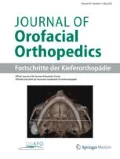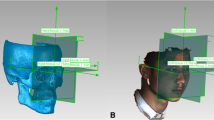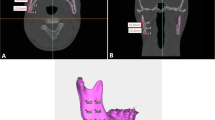Abstract
Objective:
The aim of this study was to develop a reliable threedimensional (3D) analysis of facial soft tissues. We determined the mean sagittal 3D values and relationships between sagittal skeletal parameters, and digitally recorded 3D soft tissue parameters.
Patients and Methods:
A total of 100 adult patients (nª = 53, nº = 47) of Caucasian ethnic origin were included in this study. Patients with syndromes, cleft lip and palate, noticeable asymmetry or anomalies in the number of teeth were excluded. Arithmetic means for seven sagittal 3D soft tissue parameters were calculated. The parameters were analyzed biometrically in terms of their reliability and gender-specific differences. The 3D soft tissue values were further analyzed for any correlations with sagittal cephalometric values.
Results:
Reproducible 3D mean values were defined for 3D soft tissue parameters. We detected gender-specific differences among the parameters. Correlations between the sagittal 3D soft tissue and cephalometric measurements were statistically significant.
Conclusion:
3D soft tissue analysis provides additional information on the sagittal position of the jaw bases and on intermaxillary sagittal relations. Further studies are needed to integrate 3D soft tissue analysis in future treatment planning and assessment as a supportive diagnostic tool.
Zusammenfassung
Zielsetzung:
Ziel dieser Untersuchung war die Entwicklung einer reliablen dreidimensionalen (3D) Analyse der Gesichtsweichteile. Es sollten sagittale 3D-Durchschnittswerte bestimmt werden und Beziehungen zwischen sagittalen skelettalen Parametern und digital erfassten 3D-Weichteilparametern dargestellt werden.
Patienten und Methodik:
In die Studie eingeschlossen wurden 100 erwachsene Patienten (nª = 53, nº = 47) kaukasischer Herkunft. Ausgeschlossen wurden Patienten mit Syndromen, LKGSSpalten, auffälligen Asymmetrien oder Anomalien der Zahnzahl. Es wurden arithmetische Mittelwerte für sieben sagittale 3DWeichteilparameter ermittelt. Die Parameter wurden biometrisch hinsichtlich ihrer Reliabilität und geschlechtsspezifischer Unterschiede analysiert. Des Weiteren wurden die 3D-Weichteilwerte bezüglich bestehender Korrelationen zu sagittalen kephalometrischen Werten untersucht.
Ergebnisse:
Für die 3D-Weichteilparameter konnten reproduzierbare 3D-Durchschnittswerte definiert werden. Innerhalb der Parameter ließen sich geschlechtsspezifische Unterschiede feststellen. Die Korrelationen zwischen den sagittalen 3D-Weichteilmessungen und den kephalometrischen Messungen waren statistisch signifikant.
Schlussfolgerung:
Die 3D-Weichteilanalyse lässt Aussagen sowohl über den sagittalen Einbau der Kieferbasen als auch über die sagittalen intermaxillären Beziehungen zu. Weitere Untersuchungen sind wünschenswert, um die 3D-Weichteildiagnostik zukünftig als unterstützendes diagnostisches Instrument in die Behandlungsplanung und -bewertung integrieren zu können.
Similar content being viewed by others
References
Arnett GW, Bergman RT. Facial keys to orthodontic diagnosis and treatment planning. Part I. Am J Orthod Dentofac Orthop 1993;103:299–312.
Arnett GW, Bergman RT. Facial keys to orthodontic diagnosis and treatment planning. Part II. Am J Orthod Dentofac Orthop 1993;103:395–411.
Baier B. Die Korrelation skelettaler Variablen mit Parametern der Gesichtsästhetik — eine Querschnittstudie. Med Diss, Julius-Maximilians-Universität Würzburg, 2008.
Burstone CJ. Lip posture and its significance in treatment planning. Am J Orthod 1967;53:262–84.
Burstone CJ. The integumental profile. Am J Orthod 1958;44:1–25.
Dahlberg G. Statistical methods for medical and biological students. New York: Interscience Publications, 1940.
Downs WB. Analysis of the dentofacial profile. Angle Orthod 1956;26:191–212.
Farkas LG. Anthropometry of the head and face. 2nd ed. New York: Raven Press, 1994.
Ferrario VF, Ciusa V, Tartaglia GM. The effect of sex and age on facial asymmetry in healthy subjects: a cross-sectional study from adolescence to mid-adulthood. J Oral Maxillofac Surg 2001;59:382–8.
Ferrario VF, Sforza CC, Poggio CE, Tartaglia GM. Distance from symmetry: a three-dimensional evaluation of facial asymmetry. J Oral Maxillofac Surg 1994;52:1126–32.
Gruber M, Häusler G. Simple, robust and accurate phase-measuring triangulation. Optik 1992;89:118–22.
Hajeer MY, Ayoub AF, Millett DT. Three-dimensional assessment of facial soft-tissue asymmetry before and after orthognathic surgery. Br J Oral Maxillofac Surg 2004;42:396–404.
Hartmann J, Meyer-Marcotty Ph, Benz M, et al. Reliability of a method for computing facial symmetry plane and degree of asymmetry based on 3D data. J Orofac Orthop 2007;68:477–90.
Hershon LE, Giddon DB. Determinants of facial profile self-perception. Am J Orthod 1980;78:279–95.
Holberg C. Erfassung von Gesichtsoberflächen durch ein lichtcodiertes Triangulationsverfahren. Med Diss, Universität Tübingen, 2002.
Holdaway RA. A soft-tissue cephalometric analysis and its use in orthodontic treatment planning. Part I. Am J Orthod 1983;84:1–28.
Hönn M, Diez K, Godt A, Göz, G. Perceived relative attractiveness of facial profiles with varying degrees of skeletal anomalies. J Orofac Orthop 2005;66:187–96.
Hönn M, Göz G. The ideal of facial beauty: a review. J Orofac Orthop 2007;68:6–16.
Houston WJB. The analysis of error in orthodontic measurements. Am J Orthod 1983;83:382–90.
Ing E, Safarpour A, Ing T, Ing S, Ocular adnexal asymmetry in models: a magazine photograph analysis. Can J Ophtalmol 2006;41:175–82.
Jung D, Schwarze CW, Tsutsumi S. Profile and skeletal analyses — a comparison of different assessment procedures. Fortschr Kieferorthop 1984;45:304–23.
Karbacher S. Rekonstruktion und Modellierung von Flächen aus Tiefenbildern. Diss, Friedrich-Alexander-Universität Erlangen-Nürnberg, 1997.
Kau CH, Richmond S. Three-dimensional analysis of facial morphology surface changes in untreated children from 12–14 years of age. Am J Orthod Dentofac Orthopedics 2008;134:751–60.
Kitay D, BeGole EA, Evans CA, Giddon DB. Computer-animated comparison of self-perception with actual profiles of orthodontic and nonorthodontic subjects. Int J Adult Orthod Orthognath Surg 1999;14:125–34.
Kokich VO, Kokich VG, Kiyak HA. Perceptions of dental professionals and laypersons to altered dental esthetics: asymmetric and symmetric situations. Am J Othod Dentofacial Orthop 2006;130:141–51.
Lines PA, Lines RR, Lines CA. Profilemetrics and facial esthetics. Am J Orthod 1978;73:648–57.
Merrifield L. The profile line as an aid in critically evaluating facial esthetics. Am J Orthod 1966;52:804–22.
Meyer-Marcotty P, Alpers GW, Gerdes ABM, Stellzig-Eisenhauer A. The impact of facial asymmetry in visual perception: a 3D data analysis. Am J Orthod Dentofacial Orthop; in press.
Naini FB, Moss JP, Gill DS. The enigma of facial beauty: esthetics, proportions, deformity, and controversy. Am J Orthod Dentofacial Orthop 2006;130:277–82.
Nkenke E, Vairaktaris E, Kramer M, et al. Three-dimensional analysis of changes of the malar-midfacial region after LeFort I osteotomy and maxillary advancement. Oral Maxillofac Surg 2008;12:5–12.
O’Grady KF, Antonyshyn OM. Facial asymmetry: three-dimensional analysis using laser surface scanning. Plast Reconstr Surg 1999;104:928–37.
Panagiotidis G, Witt E. Der individualisierte ANB-Winkel. Fortschr Kieferorthop 1977; 38:408–16.
Peck H, Peck S. A concept of facial esthetics. Angle Orthod 1970;40:284–318.
Plooij JM, Swennen GR, Rangel FA, et al. Evaluation of reproducibility and reliability of 3D soft tissue analysis using 3D stereophotogrammetry. Int J Oral Maxillofac Surg. 2009;38:267–73.
Powel N, Humphreys B. Proportions of the aesthetic face. New York: Thieme-Stratton Inc, 1984.
Rakosi T, Jonas I. Kieferorthopädie, Diagnostik. Farbatlanten der Zahnmedizin. Bd 8. Stuttgart: Thieme, 1989.
Rakosi T. Atlas und Anleitung zur praktischen Fernröntgenanalyse. München: Hanser Fachbuch, 1988.
Ras F, Habets LL, Van Ginkel FC, Prahl-Andersen B. Quantification of facial morphology using stereophotogrammetry — demonstration of a new concept. J Dent 1996;24:369–74.
Ricketts RM. Esthetics, environment and the law of lip relation. Am J Orthod 1968;54:272–89.
Riolo ML, Moyers RE, TenHave TR, Mayers CA. Facial soft tissue changes during adolescence. In: Carlson DS, Ribbens KA, eds. Craniofacial growth during adolescence. Monograph 20, Craniofacial Growth Series. Ann Arbor, MI: Center for Human Growth and Development; University of Michigan, 1987.
Sandler PJ. Reproducibility of cephalometric measurements. Br J Orthod 1988;15:105–10.
Schwarz AM. Die Röntgenostatik; München-Wien-Baltimore: Urban & Schwarzenberg, 1958.
Sforza C, Laino A, D’Alessio R, et al. Three-dimensional facial morphometry of attractive adolescent boys and girls. Prog Orthod 2007;8:268–81.
Stauber I, Vairaktaris E, Holst A, et al. Three-dimensional analysis of facial symmetry in cleft lip and palate patients using optical surface data. J Orofac Orthop 2008;69:268–82.
Stoner MM. A photometric analysis of the facial profile. A method of assessing facial change induced by orthodontic treatment. Am J Orthod 1955;4:453–69.
Subtelny JD. A longitudinal study of soft tissue facial structures and their profile characteristics defined in relation to underlying skeletal structures. Am J Orthod 1959;45:453–507.
Swennen GRJ, Schutyser F, Barth E, et al. A new method of 3D Cephalometry Part I: The anatomic Cartesian 3D reference system. J Craniofac Surg 2006;17:314–25.
Swennen GRJ, Schutyser F, Lemaitre A, et al. Accuracy and reliability of 3D CT versus 3D stereo photogrammetry based facial soft tissue analysis. Int J Oral Maxillofac Surg 2005:34:73.
Veit K. Verringerung systematischer Messfehler bei der phasenmessenden Triangulation. Diss, Friedrich-Alexander-Universität Erlangen-Nürnberg, 2003.
Author information
Authors and Affiliations
Corresponding author
Additional information
These authors contributed equally to this research.
Rights and permissions
About this article
Cite this article
Kochel, J., Meyer-Marcotty, P., Strnad, F. et al. 3D Soft Tissue Analysis – Part 1: Sagittal Parameters. J Orofac Orthop 71, 40–52 (2010). https://doi.org/10.1007/s00056-010-9926-x
Received:
Accepted:
Published:
Issue Date:
DOI: https://doi.org/10.1007/s00056-010-9926-x




